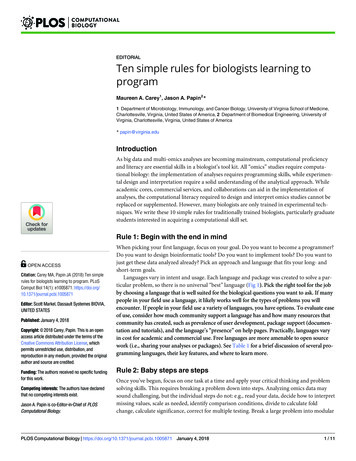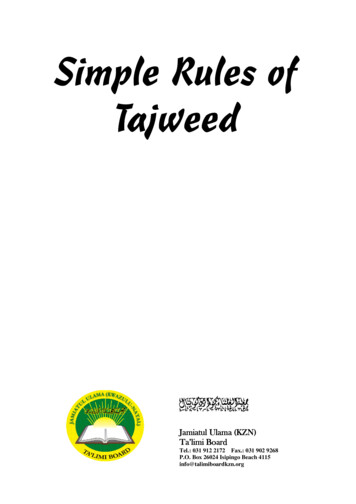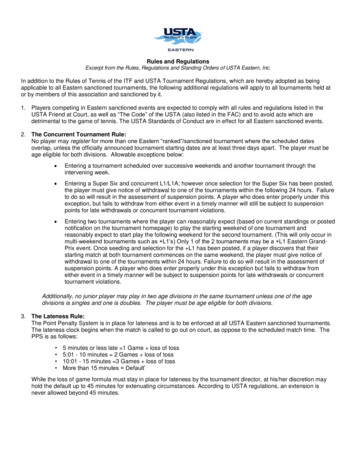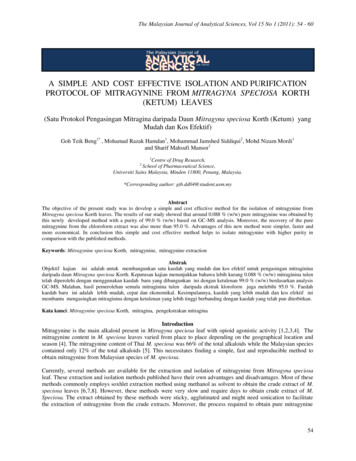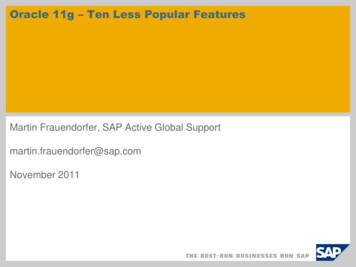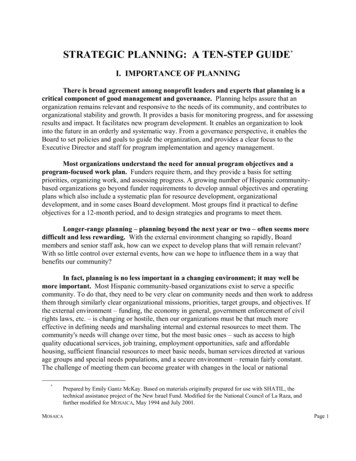
Transcription
Ten Simple Rules for Effective Statistical PracticeRobert E Kass1, Brian S Caffo2, Marie Davidian3, Xiao-Li Meng4, Bin Yu5, Nancy Reid6*1 Department of Statistics, Machine Learning Department, and Center for the Neural Basis of Cognition,Carnegie Mellon University, Pittsburgh, Pennsylvania, US, 2 Department of Biostatistics, Bloomberg School ofPublic Health, Johns Hopkins University, Baltimore, Maryland, US, 3 Department of Statistics, North CarolinaState University, Raleigh, North Carolina, US, 4 Department of Statistics, Harvard University, Boston,Massachussetts, US, 5 Department of Statistics and Department of Electrical Engineering and ComputerScience, University of California Berkeley, Berkeley California, 6 Department of Statistical Sciences, Universityof Toronto, Toronto, Ontario, CanadaIntroductionSeveral months ago, Phil Bourne, the initiator and frequent author of the wildly successfuland incredibly useful “10 Simple Rules” series, suggested that some statisticians put togethera 10 Simple Rules article related to Statistics. (One of the rules for writing a PLOS ten simplerules article is to be Phil Bourne [1]. In lieu of that, we hope effusive praise for Phil willsuffice.)Implicit in the guidelines for writing 10 simple rules [1] is “know your audience.” Wedeveloped our list of rules with researchers in mind: researchers having some knowledge ofstatistics, possibly with one or more statisticians available in their building, or possibly with ahealthy do-it-yourself attitude and a handful of statistical packages on their laptops. We drewon our experience in both collaborative research and teaching, and, it must be said, with ourfrustration of being asked, more than once, to “take a quick look at my student’s thesis/mygrant application/my referee’s report: it needs some input on the stats, but it should be prettystraightforward”.There are some outstanding resources available that explain many of these concepts clearlyand in much more detail than we have been able to do here: among our favorites are Coxand Donnelly [2], Leek [3], Peng [4], Kass et al. [5], Tukey [6] and Yu [7].Caveat: Every article on statistics requires at least one caveat. Here is ours. We refer in thisarticle to “science” as a convenient short-hand for investigations using data to studyquestions of interest. This includes social science, and engineering, and digital humanities,*Email: reid@utstat.utoronto.ca
and finance, and so on. Statisticians are not shy about reminding administrators thatstatistical science has an impact on nearly every part of almost all organizations.Rule 1: Statistical methods should enable data to answer scientific questions.A big difference between inexperienced users of statistics and expert statisticians appears assoon as they contemplate the uses of some data. While it is obvious that experimentsgenerate data to answer scientific questions, inexperienced users of statistics tend to take forgranted the link between data and scientific issues and, as a result, may jump directly to atechnique based on data structure rather than scientific goal. For example, if the data were ina table, as for microarray gene expression data, they might look for a method by asking,“Which test should I use?” while a more experienced person would, instead, start with theunderlying question, such as, “Where are the differentiated genes?” and, from there, wouldconsider multiple ways the data might provide answers. Perhaps a formal statistical testwould be useful, but other approaches might be applied as alternatives, such as heat mapsor clustering techniques. Similarly, in neuroimaging understanding brain activity undervarious experimental conditions is the main goal; illustrating this with nice images issecondary. This shift in perspective from statistical technique to scientific question maychange the way one approaches data collection and analysis. After learning about thequestions, statistical experts discuss with their scientific collaborators the ways that datamight answer these questions, and thus what kinds of studies might be most useful; together,they try to identify potential sources of variability, and what hidden realities could break thehypothesized links between data and scientific inferences; and only then do they developanalytic goals and strategies. This is a major reason why collaborating with statisticians canbe helpful, and also why the collaborative process works best when initiated early in aninvestigation. See Rule 3.Rule 2: Signals always come with noise.Grappling with variability is central to the discipline of statistics. Variability comes in manyforms. In some cases variability is good, since we need variability in predictors to explainvariability in outcomes. For example, to determine if smoking is associated with lung cancer,we need variability in smoking habits; to find genetic associations with diseases, we needgenetic variation. Other times variability may be annoying, such as when we get threedifferent numbers when measuring the same thing three times. This latter variability is usuallycalled “noise,” in the sense that it is either not understood or thought to be irrelevant.Statistical analyses aim to assess the signal provided by the data, the interesting variability,in the presence of noise, or irrelevant variability.
A starting point for many statistical procedures is to introduce a mathematical abstraction:outcomes, such as patients being diagnosed with specific diseases, or receiving numericalscores on diagnostic tests, will vary across the set of individuals being studied, and statisticalformalism describes such variation using probability distributions. Thus, for example, a datahistogram might be replaced, in theory, by a probability distribution, thereby shifting attentionfrom the raw data to the numerical parameters that determine the precise features of theprobability distribution, such as its shape, its spread, or the location of its center. Probabilitydistributions are used in statistical models, with the model specifying the way signal andnoise get combined in producing the data we observe, or would like to observe. Thisfundamental step makes statistical inferences possible. Without it, every data value would beconsidered unique, and we would be left trying to figure out all the detailed processes thatmight cause an instrument to give different values when measuring the same thing severaltimes. Conceptualizing signal and noise in terms of probability within statistical models hasproven to be an extremely effective simplification, allowing us to capture the variability in datain order to express uncertainty about quantities we are trying to understand. The formalismcan also help by directing us to look for likely sources of systematic error, known as bias.Big data makes these issues more important, not less. For example, Google Flu Trendsdebuted to great excitement in 2008, but turned out to over-estimate the prevalence ofinfluenza by nearly 50%, largely due to bias caused by the way the data were collected; seeHarford [8], for example.Rule 3: Plan ahead, really ahead.When substantial effort will be involved in collecting data, statistical issues may not becaptured in an isolated statistical question such as, “What should my n be?” As wesuggested in Rule 1, rather than focusing on a specific detail in the design of the experiment,someone with a lot of statistical experience is likely to step back and consider many aspectsof data collection in the context of overall goals, and may start by asking, “What would be theideal outcome of your experiment, and how would you interpret it?” In trying to determinewhether observations of X and Y tend to vary together, as opposed to independently, keyissues would involve the way X and Y are measured, the extent to which the measurementsrepresent the underlying conceptual meanings of X and Y, the many factors that could affectthe measurements, the ability to control those factors, and whether some of those factorsmight introduce systematic errors (bias).In Rule 2 we pointed out that statistical models help link data to goals by shifting attention totheoretical quantities of interest. For example, in making electrophysiological measurementsfrom a pair of neurons, a neurobiologist may take for granted a particular measurement
methodology along with the supposition that these two neurons will represent a whole classof similar neurons under similar experimental conditions. On the other hand a statistician willimmediately wonder how the specific measurements get at the issue of co-variation; what themajor influences on the measurements are, and whether some of them can be eliminated byclever experimental design; what causes variation among repeated measurements, and howquantitative knowledge about sources of variation might influence data collection; andwhether these neurons may be considered to be sampled from a well-defined population,and how the process of picking that pair could influence subsequent statistical analyses. Aconversation that covers such basic issues may reveal possibilities an experimenter has notyet considered.Asking questions at the design stage can save headaches at the analysis stage: careful datacollection can greatly simplify analysis, and make it more rigorous. Or, as Sir Ronald Fisherput it: “To consult the statistician after an experiment is finished is often merely to ask him toconduct a post mortem examination. He can perhaps say what the experiment died of” [9].As a good starting point for reading on planning of investigations, see Chapters 1 through 4of [2].Rule 4: Worry about data quality.Well-trained experimenters understand instinctively that when it comes to data analysis,“garbage in produces garbage out.” However, the complexity of modern data collectionrequires many assumptions about the function of technology, often including data preprocessing technology. It is highly advisable to approach pre-processing with care, as it canhave profound effects that easily go unnoticed.Even with pre-processed data, further considerable effort may be needed prior to analysis;this is variously called “data cleaning,” “data munging,” or “data carpentry.” Hands-onexperience can be extremely useful, as data cleaning often reveals important concerns aboutdata quality, in the best case confirming that what was measured is indeed what wasintended to be measured, and in the worst case ensuring that losses are cut early.Units of measurement should be understood, and recorded consistently. It is important thatmissing data values can be recognized as such by relevant software. For example, 999 maysignify the number 999, or it could be code for “we have no clue.” There should be adefensible rule for handling situations such as “non-detects,” and data should be scanned foranomalies such as variable 27 having half its values equal to 0.00027. Try to understand asmuch as you can how these data arrived at your desk or disk. Why are some data missing or
incomplete? Did they get lost through some substantively relevant mechanism?Understanding such mechanisms can help to avoid some seriously misleading results. Forexample, in a developmental imaging study of attention deficit hyperactivity disorder, mightsome data have been lost from children with the most severe hyperactivity because theycould not sit still in the MR scanner?Once the data have been wrestled into a convenient format, have a look! Tinkering aroundwith the data, also known as exploratory data analysis, is often the most informative part ofthe analysis. Exploratory plots can reveal data quality issues and outliers. Simple summariessuch as means, standard deviations and quantiles can help refine thinking and offer facevalidity checks for hypotheses. Many studies, especially when going in completely newscientific directions, are exploratory by design; the area may be too novel to include clear apriori hypotheses. Working with the data informally can help generate new hypotheses andideas. However, it is also important to acknowledge the specific ways data are selected priorto formal analyses, and to consider how such selection might affect conclusions. And it isimportant to remember that using a single set of data to both generate and test hypotheses isproblematic. See Rule 9.Rule 5: Statistical analysis is more than a set of computations.Statistical software provides tools to assist analyses, not define them. The scientific contextis critical, and the key to principled statistical analysis is to bring analytic methods into closecorrespondence with scientific questions. See Rule 1. While it can be helpful to includereferences to a specific algorithm or piece of software in the Methods section of a paper, thisshould not substitute for an explanation of the choice of statistical method in answering aquestion. A reader will likely want to consider the fundamental issue of whether the analytictechnique is appropriately linked to the substantive questions being answered. Don’t makethe reader puzzle over this: spell it out clearly.At the same time, a structured algorithmic approach to the steps in your analysis can be veryhelpful in making this analysis reproducible, by yourself at a later time, or by others with thesame, or similar data. See Rule 10.Rule 6: Keep it simple.All else being equal, simplicity trumps complexity. This rule has been rediscovered andenshrined in operating procedures across many domains, and variously described as“Occam’s razor”, “KISS”, “less is more”, and “simplicity is the ultimate sophistication.” The
principle of parsimony can be a trusted guide: start with simple approaches and only addcomplexity as needed, and then only add as little as seems essential.Having said this, scientific data have detailed structure, and simple models can’t alwaysaccommodate important intricacies. The common assumption of independence is oftenincorrect, and nearly always needs careful examination. See Rule 8. Large numbers ofmeasurements, interactions among explanatory variables, nonlinear mechanisms of action,missing data, confounding, sampling biases, and so on, can all require an increase in modelcomplexity.Keep in mind that good design, implemented well, can often allow simple methods ofanalysis to produce strong results. See Rule 3. Simple models help us to create order out ofcomplex phenomena, and simple models are well suited for communication to our colleaguesand the wider world.Rule 7: Provide assessments of variability.Nearly all biological measurements, when repeated, exhibit substantial variation, and thiscreates uncertainty in the result of every calculation based on the data. A basic purpose ofstatistical analysis is to help assess uncertainty, often in the form of a standard error orconfidence interval, and one of the great successes of statistical modeling and inference isthat it can provide estimates of standard errors from the same data that produce estimates ofthe quantity of interest. When reporting results it is essential to supply some notion ofstatistical uncertainty. A common mistake is to calculate standard errors without taking intoaccount the dependencies among data or variables, which usually means a substantialunderestimate of the real uncertainty. See Rule 8.Remember that every number obtained from the data by some computation would changesomewhat, even if the measurements were repeated on the same biological material. If youare using new material, you can add to the measurement variability an increase due to thenatural variability among samples. If you are collecting data on a different day, or in adifferent lab, or under a slightly changed protocol, there are now three more potential sourcesof variability to be accounted for. In micro-array analysis, batch effects are well-known tointroduce extra variability, and several methods are available to filter these. Extra variabilitymeans extra uncertainty in the conclusions, and this uncertainty needs to be reported. Suchreporting is invaluable as well for planning the next investigation.It is a very common feature of big data that uncertainty assessments tend to be overlyoptimistic (Cox [10], Meng [11]). For an instructive, and beguilingly simple, quantitative
analysis most relevant to surveys, see the “data defect” section of [11]. Big data is notalways as big as it looks: a large number of measurements on a small number of samplesrequires very careful estimation of the standard error, not least because these measurementsare quite likely to be dependent.Rule 8: Check your assumptions.Every statistical inference involves assumptions, assumptions that are based on substantiveknowledge and some probabilistic representation of data variation----this is what we call astatistical model. Even the so-called “model-free” techniques do require assumptions, albeitless restrictive assumptions, so this terminology is somewhat misleading.The most common statistical methods involve an assumption of linear relationships. Forexample, the ordinary correlation coefficient, also called Pearson correlation, is a measure oflinear association. Linearity often works well as a first approximation, as a depiction of ageneral trend, especially when the amount of noise in the data makes it difficult to distinguishbetween linear and nonlinear relationships. However, for any given set of data, theappropriateness of the linear model is an empirical issue, and should be investigated.In many ways a more worrisome, and very common, assumption in statistical analysis is thatmultiple observations in the data are statistically independent. This is worrisome becauserelatively small deviations from this assumption can have drastic effects. Whenmeasurements are made across time, for example, the temporal sequencing may beimportant; if it is, specialized methods appropriate for time series need to be considered.In addition to nonlinearity and statistical dependence, missing data, systematic biases inmeasurements, and a variety of other factors can cause violations of statistical modelingassumptions, even in the best experiments. Widely available statistical software makes iteasy to perform analyses without careful attention to inherent assumptions, and this risksinaccurate, or even misleading, results. It is therefore important to understand theassumptions embodied in the methods you are using, and to do whatever you can tounderstand and assess those assumptions. At a minimum you will want to check how wellyour statistical model fits the data. Visual displays and plots of data and of residuals fromfitting are helpful for evaluating the relevance of assumptions and the fit of the model, andsome basic techniques for assessing model fit are available in most statistical software.Remember though that several models can “pass the fit test” on the same data. See Rule 1and Rule 6.
Rule 9: When possible, replicate!Every good analyst examines the data at great length, looking for patterns of many types,searching for predicted and unpredicted results. This process often involves dozens ofprocedures, including many alternative visualizations and a host of numerical slices throughthe data. Eventually, some particular features of the data are deemed interesting andimportant, and these are often the results reported in the resulting publication.When statistical inferences, such as p-values, follow extensive looks at the data, they nolonger have their usual interpretation. Ignoring this reality is dishonest: it is like painting abull’s eye around the landing spot of your arrow. This is known in some circles as p-hacking,and much has been written about its perils and pitfalls: see, for example, [12] and [13].Recently there has been a great deal of criticism of the use of p-values in science, largelyrelated to the misperception that results can’t be worthy of publication unless “p is less than0.05”. The recent statement from the American
Ten Simple Rules for Effective Statistical Practice Robert E Kass1, Brian S Caffo2, Marie Davidian3, Xiao-Li Meng4, Bin Yu5, Nancy Reid6* 1 Department of Statistics, Machine Learning Department, and Center for the Neural Basis of Cognition, Carnegie Mellon University, Pittsburgh, Pennsylvania, U
